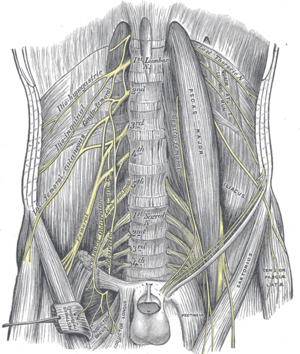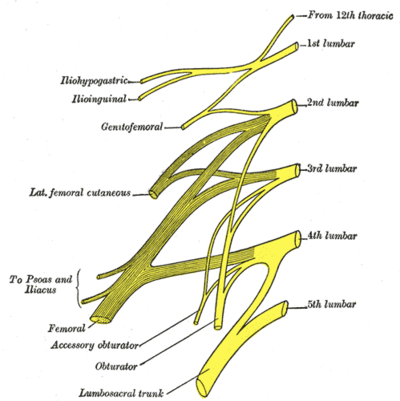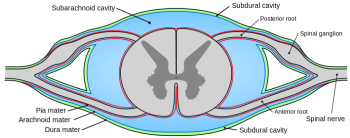Lumbar Plexus
Original Editor - Carla Benton
Top Contributors - Carla Benton, Kim Jackson, Admin, Laura Ritchie, Lucinda hampton, Libby McConnell, Evan Thomas, WikiSysop and Carina Therese Magtibay
Introduction[edit | edit source]
The lumbar plexus is an essential collection of nerves that arise from mostly the lumbar spinal cord.
- The term plexus refers to a “web” of nerves that is created just lateral to where T12-L5 exit the spinal cord via intervertebral foramina.
- The plexus exists bilaterally and allows nerves to combine with different levels to create multiple functioning nerves that serve to innervate various structures.
- The primary functions of these nerves are motor innervation and sensory nerves to the skin mainly in the lower extremities, although the superior nerves in the plexus do contribute to the lower abdomen and pelvis.
- The nerves arising from the lumbar plexus are vital for the functioning of the lower extremity and maintaining the ability to extend the knee, flex the hip, adduct the thigh, and more[1].
Nerves[edit | edit source]
The nerves arising from the lumbar plexus from superior to inferior are listed below.
- The iliohypogastric nerve is created from spinal levels T12 and L1. Motor innervation: internal oblique muscle; transverse abdominal muscles. Sensory inputs: lateral gluteal area.
- The ilioinguinal nerve derives from a branch of the L1 spinal nerve. Sensory inputs: anterior superior and medial parts of the thigh; males, the distal portions of the nerve become the anterior scrotal nerve that inputs sensory fibers to the root of the penis and the superior part of the scrotum; females, the distal portions of the nerve are the anterior labial nerves that help to provide sensory inputs to the skin covering the mons pubis and the labia majora. Motor inputs: internal oblique muscle; transverse abdominal muscles.
- The genitofemoral nerves arise from the superior aspects of L1 and L2 spinal nerves. The nerve separates into the genital and the femoral branch. Genital branch supplies the cremaster muscle and scrotal skin in men and supplies sensory to the mons pubis and the labia majora in women. Genitofemoral nerve's femoral branch provides sensory innervation the anterior, superior area of the thigh.
- The lateral femoral cutaneous nerve comes from the L2 and L3 spinal nerves. Singular function of supplying sensory innervation to much of the lateral portion of the thigh.
- The femoral nerve ranks as the largest nerve that arises from the lumbar plexus. It is created from lumbar spinal nerves L2, L3, and L4. See link.
- The obturator nerve arises from L2, L3, and L4 spinal nerves. It provides the primary motor supply to the medial (adductor) muscle compartment of the thigh. See link[1].
File:Interactive spine - intevertebral foramina - L1F8.jpg Intervertebral Foramina, used with permission from Primal Pictures |
The angle each pair of nerve roots leaves the dural sac varies. L1-2 roots leave the dural sac at an obtuse angle, but the dural sleeves of the lower nerve roots form increasingly acute angles. The angles formed by the L1 and L2 roots are about 80 degrees and 70 degrees, while the angles of the L3 and L4 roots are about 60 degrees.[2] Lumbar 1 through Lumbar 4 donate their anterior rami to creating the lumbar plexus. Sometimes a few fibers from Thoracic 12 are also attached as well. The lumbar plexus innervates the structures of the lower abdomen. The anterior and medial segments of the lower extremity are also innervated. The smaller part of the fourth lumbar nerve joins with the fifth to form the lumbosacral trunk, which forms the sacral plexus. The fourth nerve is named the nervus furcalis, because it is subdivided between the two plexuses.
The branches of the lumbar plexus form the following nerves:
- L1-Iliohypogastric and Ilioinguinal
- L1, L2-Genitofemoral dorsal divisions
- L2, L3-Lateral femoral cutaneous
- L2,L3,L4-Femoral, ventral divisions
- L2, L3, L4-Obturator
- L3, L4-Accessory obturator
The lumbar spine has an extensive innervation system. Posteriorly, branches from the lumbar dorsal rami are distributed to the zygapophysial joints and the back muscles. Anteriorly, the ventral rami supply the quadratus lumborum and psoas major. The vertebral bodies and intervertebral discs are surrounded by plexuses that accompany the longitudinal ligaments and which are derived from the lumbar sympathetic trunks. Within the posterior plexus, larger branches compose the sinuvertebral nerves. Short branches innervate the vertebral periosteum, while long branches enter the vertebral body from all aspects of its circumference. Nerves enter the outer third of the annulus fibrosis from the longitudinal plexuses anteriorly, laterally and posteriorly. The posterior plexus innervates the dura mater and nerve root sleeves. The posterior division also yields the femoral nerve. This is the most important nerve from the lumbar plexus. It innervates the anterior and lateral thigh muscles, as well as medial leg and ending at the foot. The femoral nerve also innervates the quadratus femoris, iliopsoas, and the sartorius muscle with motor coordination. The anterior division of the lumbar plexus yields the obturator nerve. It innervates the cutaneous areas of the medial thigh and the abductor hip musculature.[3]
It is crucial as physical therapists to have a strong knowledge base and understanding of the lumbar plexus in the treatment of our orthopedic patients. In order to accurately determine the cause of our patients' pain or dysfunction, analyzing which level is affected can help us to make better intervention choices, which in turn will create better outcomes.Many times our patients present with only lower extremity deficits, however these often times, are initiated from the lumbar plexus, and not the extremity. Being able to utilize our anatomy and physiology in treating our patients with musculoskeletal dysfunctions can help our patients progress more effectively and quicker, which will help decrease costs of extended treatment due to misdiagnosis. Applying this anatomy with our patients who receive spinal blocks and epidurals can also help us determine the most effective treatment approach and better understand our patient's presentation in the clinic.
Resources[edit | edit source]
- Bogduk, N. Clinical Anatomy of the Lumbar Spine and Sacrum. 3rd edition, Edinburgh: Churchill Livingstone; 1997. Figure 10-13, page 143; Figure 10.1, page 128.
References[edit | edit source]
- ↑ 1.0 1.1 Singh O, Al Khalili Y. Anatomy, Back, Lumbar Plexus. In: StatPearls. StatPearls Publishing, Treasure Island (FL); 2019.Available from:https://www.ncbi.nlm.nih.gov/books/NBK545137/ (last accessed 14.9.2020)
- ↑ Bogduk, N. Clinical Anatomy of the Lumbar Spine and Sacrum. 3rd edition, Edinburgh: Churchill Livingstone; 1997
- ↑ Lumbar nerve plexus Website. Available at http://www.medical-look.com/human_anatomy/organs/Lumbar_nerve_plexus.html/. Accessed November 19, 2009.









